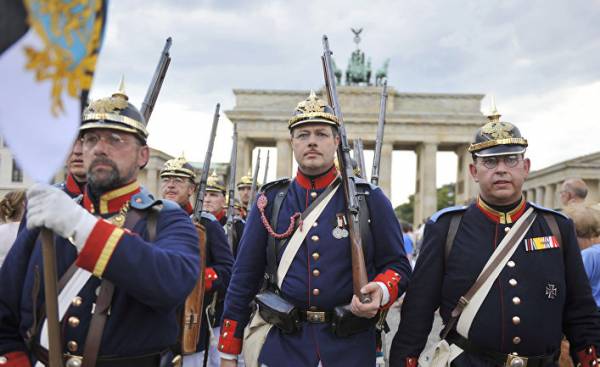
Prince Leopold I von Anhalt-Dessau (Leopold I. von Anhalt-Dessau, 1676-1747) was a living proof that high-ranking representatives of the old regime has turned to the present. At the age of 19 years he inherited the tiny Principality with an area of approximately 600 square kilometers with a population of approximately 30 thousand people, which was ravaged during the Thirty years war. Leopold immediately launched reforms, soon made Anhalt-Dessau strong financial model country of the Holy Roman Empire of the German nation.
But the name “the old man from Dessau” went down in history not due to its economic, scientific or administrative reforms, but rather one and the same invention with a length of exactly one meter and a diameter of approximately 15 millimeters. It was called iron rifle cleaning rod for muskets, which were charged from the barrel.
Leopold invented this useful tool, which had a big impact, when he was a Colonel General and field Marshal of the Brandenburg-Prussian army. He served Frederick I, Frederick William I and Frederick II as a commander, strategist and Advisor. But first and foremost he has earned a name for himself as a reformer of the army, which was in its infancy the army of the bankrupt middle States has created the most effective army on the continent, with which Frederick the Great had to go through the Silesian wars.
The material contribution of Leopold in these developments was the iron ramrod. As a young Colonel in the service of the elector and later king of Prussia Frederick III, this native of Dessau replaced wooden auxiliary means required for loading guns, the metal. This was a consequence of the application of another technological novelty, which was tied to the main weapon of the infantry. After the Thirty years war burning fuse that was needed for the explosion of the powder charge in the musket has been replaced with flint, which made the gun impervious to moisture.
The iron ramrod is allowed to charge faster and more reliable. Unlike its wooden predecessor, it did not break and did not bring weapons into disrepair.
New ramrod has led to the fact that Leopold developed a new Charter that became the basis of the reform of the army. Its main idea was that the soldiers should form part of the disciplined, where each of the arrows with the same accuracy and speed wore, loaded his weapon and is made from a shots. To do this, always worked out every move and each technique. First on the shelf rifles pour the powder, then the barrel laid a charge of gunpowder and bullet, and used new cleaning rod. Then rank the team made a shot, while the rest of the soldiers, who were shooting in front or behind them, again prepared their weapons to fire.
In 1729, king Frederick William I introduced the innovation of Leopold in the whole of the Prussian army. Son of the “king of soldiers” Frederick the Great said, “the Prince von Anhalt, who knows very well the craft of war, I noticed that shotguns are not used in full. He introduced the iron ramrod and instilled in soldiers an incredible rate of fire. First exploring the techniques. Were shooting separate platoons and divisions. Then firing was carried out at slow progress and in the same way when reversing… All the exercise in the end, was executed pobatalonno with the impeccable precision of clockwork”.
For perfect functioning of this clockwork had another novelty Leopold — synchronous step. He sought to have all troopers always the same maneuver with his friends and simultaneously held his position in the ranks. Mobility and speed of the fire was checked by the officers watch in hand. In addition, the movement of soldiers in rows and lines led to the fact that soldiers in the heat of battle maintained his position and did not respond to the first impulse is to run and jump.
Increased mobility and rapid alternation of shots led to a change in tactics. If before line Fusiliers marching ranks, whose number reached six, now a Prussian military has reduced this number to three. With the iron ramrod Prussian hands could produce up to three shots per minute, while the Austrian or the Russian could only do two shots per minute. Prussian triple line with a smaller number of soldiers has reached more firepower than their opponents in the Silesian wars.
The length of the muskets and ramrods, mounted on the barrel, explained also by the passion with which Frederick William I was looking for his guard the famous “long man” (minimum height of 1.72 meters). The higher were the soldiers, the easier and faster it can perform difficult tricks of the loader arms.
However, the iron ramrod was also a means of discipline. Even for the slightest misdemeanor soldiers could be punished shpitsrutenami. The punishment, which initially was used in mercenaries, hired to punish soldiers for a breach of ethics in the age of absolutism served only to maintain discipline, violation of which, in the first place, it was considered desertion. Sentenced were under the drums to run through a gauntlet of his comrades, who struck at his body. But compared with the former current punishment has rarely been fatal, the case, the soldier was too valuable to lose it that way.
When Frederick William I died in 1740, he left his son Frederick of the army with which he was able to intervene immediately in the big game rulers of Europe. That was achieved thanks to the reform of the army, held a guy from Dessau, say two digits. In 1714, the troops lost because of desertion 8% of its power. 26 years later, it was only 0.4%.







